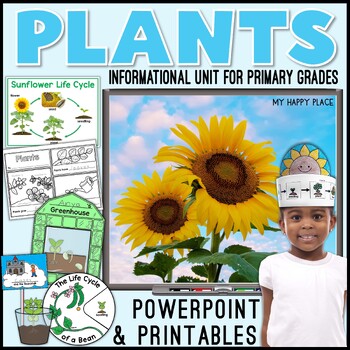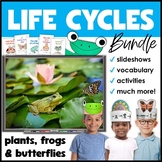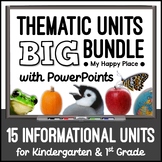Plant Unit – All About Plants Slideshow, Life Cycle Activities, Craft, and More
- Zip
What educators are saying
Also included in
- This bundle of spring life cycle units is packed with engaging activities sure to spark your students’ curiosity and fill their days with active learning. The three engaging themes (All About Frogs, All About Butterflies, and All About Plants) in this bundle provide primary students with the interesPrice $16.20Original Price $22.50Save $6.30
- Keep your students excited about learning all year long with these informational thematic units for kindergarten and first grade! Each of the 15 units in this set includes a nonfiction PowerPoint slideshow full of eye-catching photos and clear informational text. In addition, with each theme comes aPrice $62.00Original Price $94.75Save $32.75
Description
This plant unit is packed full of learning and fun! Complete with an informational “All About Plants” PowerPoint, a plant life cycle wheel, a hat/crown, a planting activity (with a mini greenhouse), and lots of printable materials, this set will turn your students into little botanists. With eye-catching display materials including headers for three anchor charts along with colorful vocabulary word posters and word wall cards, children will have what they need to read, talk, and write about plants. This plant unit teaches students about the life cycle, parts of a plant, human uses for plants, and more!
This informational plants unit is also included in this Thematic Units BIG Bundle and in this Life Cycles Bundle.
What’s included in this plant unit?
This “All About Plants” thematic unit includes materials to help you integrate learning about plants into science, social studies, literacy, and math in your primary classroom. You will download a zipped folder including a PPT file and a PDF.
Here’s what’s included:
✔ Informational PowerPoint Slideshow “All About Plants”
This slideshow is packed full of information about plants. Filled with clear photographs, this presentation includes nonfiction text about different types of seeds and plants and their features and parts, the life cycle of plants, human uses for and effects on plants, and more. This PowerPoint slideshow is 20 slides long and is copied at the end of the PDF in addition to the PPT file (for those without access to PowerPoint).
✔ Plant Vocabulary Word Posters and Word Wall Cards
The included plant vocabulary word posters, each with a photo and a simple definition, are germination, seedling, soil, pollen, pollination, photosynthesis, and greenhouse. The word wall cards, each with an illustration, are plant, roots, stem, leaf, flower, air, soil, sun, water, seed, bud, rain, fruit, vegetable, and wood.
✔ Anchor Chart Materials and Posters
Printable materials are included to help you create meaningful plant anchor charts with your students. You’ll find what you need to make a Plants KWL chart, a “Have, Need, Give” chart, and a “Where Are the Seeds?” comprehension chart (pocket chart activity). In addition, this set includes a “Parts of a Plant” poster, three “Plant Life Cycle” posters (sunflower, strawberry, and bean), and an illustrated song and poem to display.
✔ Printable Plant Activities
▶ Themed Informational Writing Materials: In addition to writing organizers, this set includes various plant-themed lined writing sheets, a Have/Need/Give book template, and scaffolded writing templates.
▶ Plant Science Activities: Students cut and glue to complete these life cycle and parts of a plant worksheets. This section includes a “How Seeds Travel” worksheet and life cycle-themed writing paper. A note to families facilitates a seed collection and exploration activity. In addition, you will find materials for a planting activity with teacher tips (for planting seeds in a sandwich bag or a cup), templates for a mini greenhouse and a “Jack and the Beanstalk” castle accessory, a bean observation recording sheet, and two versions of a planting journal.
▶ Cut and Fold Plant Book: This informational easy reader is designed to be printed double-sided, using only one sheet of paper. Students can color the pictures, then practice reading and print concepts. This book has one simple sentence per page.
▶ Plant Life Cycle Wheel: This simple, one-page craft allows children to assemble a life cycle wheel using a brass fastener. This gives children the chance to visualize and talk about the life cycle of a bean.
▶ Plant Life Cycle Crown: Use a sentence strip to complete this simple hat that has children cut and glue the plant life cycle in order. This cute crown is a great culminating activity for your plan unit. Visual directions are included.
▶ Thematic Printables: This section includes a selection of reading and math skill worksheets with a plant theme. The language arts pages include comprehension passages, capitalization and punctuation pages, a rhyming sheet, and an -ot word family cut and glue page. The math skills included are addition (within 10), subtraction (within 5), teen numbers, and missing numbers (within 10).
How do I use this All About Plants unit?
Begin by accessing students’ background knowledge about plants by having a class discussion. As you discuss, fill in the “K” (What I Know) and “W” (What I Want to Know) columns of the KWL chart. Follow up with the PowerPoint slideshow, which can be read aloud in one sitting or can be used across several days. Young children will need time to discuss the information as it is presented, so be sure to build in time for conversations and questions! Upon completion of the PowerPoint (or as you go along), have students help fill in the final column of the KWL chart.
To guide students toward informational writing about plants, begin with the “Have, Need, Give” chart, having the students help determine what you should write in each section (a sample chart is included). Students can then begin to work on their own organizers which will scaffold them toward writing three informational sentences about plants. The Have/Need/Give book template, which is included in three levels of difficulty, is a great way for students to showcase their writing skills.
The “Where Are the Seeds?” chart and the accompanying writing template help students build comprehension and practice sorting skills. These cards can be used in a pocket chart as a whole group activity. Have students sort whether the various seed cards belong in the pod, cone, fruit, or flower section. Then build sentences with the word cards.
The original seedling song (to be sung to the tune of “I’m a Little Teapot”) and the plant poem help students remember facts about plants while also working on memorization and rhyme concepts. Consider having students come up with hand motions to go along with the song. Students can sing the song and recite the poem while wearing their hats! A cut-and-glue comprehension sheet accompanies the poem.
The thematic activities can be completed in any order (and you can pick and choose based on the needs and levels of your students).
Have students make plant life cycle hats to culminate their studies and encourage them to share plant facts with anyone who asks about their hat!
This informational plants unit is also included in this Thematic Units BIG Bundle and in this Life Cycles Bundle.
What Teachers Are Saying about “All About Plants”:
⭐⭐⭐⭐⭐ “Love using the My Happy Place informational units that match our district curriculum. PowerPoints are awesome!! Students loved this plant unit.” — Nan S.
⭐⭐⭐⭐⭐ “I loved using this product. Engaging activity ideas, appealing design, thorough coverage of the topic, and easy to use in a way that met the needs of both my kindergarten and second grade homeschool students. I have used several of your themed units and can't wait for you to make more!” — Laura L.
⭐⭐⭐⭐⭐ “Really loved this product! The PowerPoint was colorful, engaging, and clear! My first graders really loved working through this unit. Thank you!” — Anna D.
⭐⭐⭐⭐⭐ “I love that this resource has so much information for students but is still simple enough for kinder. My students loved completing their books and were so proud to have them on display for Open House!” — Kassidy T.
You may also like:
▶ All About Butterflies Unit
▶ Pond Life Unit
▶ All About Frogs Unit
▶ Fine Motor Activities for Spring
Please see the preview file for more detailed images. If you have any questions, email susan@myhappyplaceteaching.com or use the “Q&A” feature on this page.
I would love to have you as a follower! Click the green star to be the first to know about new resources.
Thank you for shopping!
Susan Jennings (My Happy Place)
___________________________________
Copyright © My Happy Place Teaching Resources
Permission to copy for single classroom use only.
Please purchase additional licenses if you intend to share this product.







